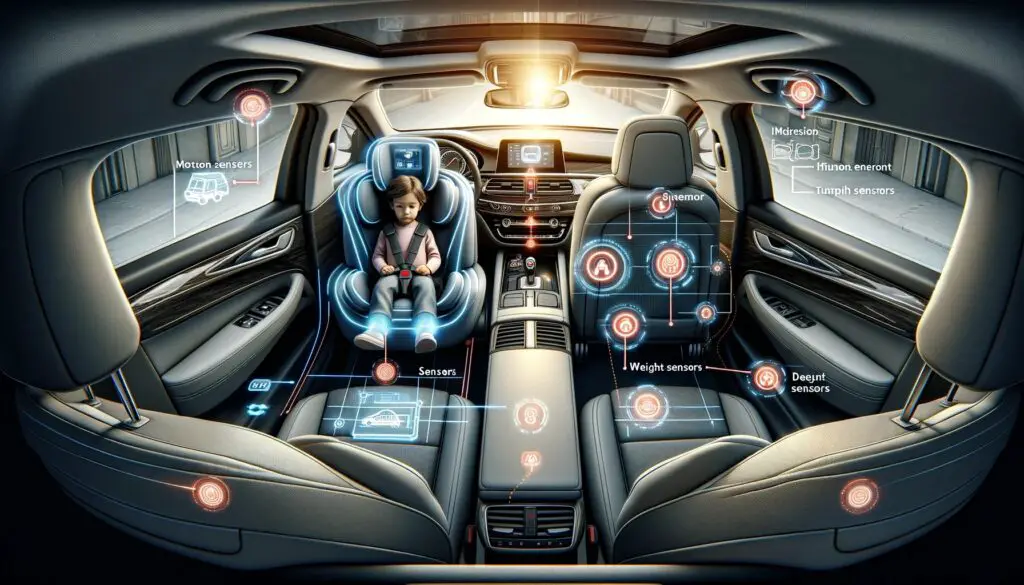Child safety in vehicles is a paramount concern for parents and caregivers worldwide. With an increasing number of incidents related to children being left unattended in vehicles, the demand for innovative safety solutions has surged. In this article, we delve into the realm of child presence detection systems, exploring their significance, functionality, market dynamics, regulatory landscape, technological advancements, and future outlook.
Understanding Child Presence Detection Systems
Child presence detection systems are advanced technologies designed to alert caregivers when a child is left unattended in a vehicle. These systems utilize various sensors and algorithms to detect the presence of a child and issue timely alerts to caregivers, thereby preventing potential accidents or fatalities.
Definition and Primary Functions
At the core, child presence detection systems aim to mitigate the risks associated with leaving children unattended in vehicles. They operate by sensing the presence of a child through a combination of sensors, such as weight sensors, seat sensors, or motion sensors, and triggering alerts through auditory or visual cues.
How Do These Systems Work?
Child presence detection systems employ a combination of sensor technologies, including infrared sensors, ultrasonic sensors, and pressure sensors, to detect the presence of a child inside a vehicle. These sensors are strategically placed within the vehicle’s interior, such as the seats or door panels, to ensure comprehensive coverage. Upon detecting the presence of a child, the system activates alarms or notifications to alert caregivers.
The Evolution of Child Presence Detection Systems
Over the years, child presence detection systems have undergone significant evolution, leveraging advancements in sensor technology, artificial intelligence, and connectivity. Early systems relied primarily on weight sensors, whereas modern solutions integrate multiple sensor types and sophisticated algorithms to enhance accuracy and reliability.
Market Dynamics
The market for child presence detection systems is driven by several factors, including growing awareness of child safety issues, stringent regulatory standards, and technological advancements in automotive safety. However, challenges such as cost concerns, integration complexities, and consumer reluctance pose barriers to market growth.
Key Drivers
The increasing incidence of vehicular heatstroke fatalities among children, coupled with rising awareness of child safety regulations, serves as a primary driver for the adoption of child presence detection systems. Additionally, advancements in sensor technology and vehicle connectivity contribute to market expansion.
Challenges and Barriers
Despite the growing demand for child presence detection systems, challenges persist in areas such as cost-effectiveness, system reliability, and compatibility with existing vehicle infrastructure. Addressing these challenges requires collaborative efforts from automotive manufacturers, technology providers, and regulatory authorities.
Opportunities for Growth and Innovation
The emergence of smart car ecosystems, coupled with advancements in artificial intelligence and IoT technologies, presents significant opportunities for innovation in child presence detection systems. By leveraging these technologies, manufacturers can develop more robust and intelligent solutions capable of addressing evolving safety requirements.
Regulatory Landscape
The regulatory landscape plays a crucial role in shaping the adoption and design of child presence detection systems. Global safety regulations mandate the implementation of safety features in vehicles to mitigate the risks of child-related accidents and fatalities.
Overview of Global Safety Regulations and Standards
Regulatory bodies such as the National Highway Traffic Safety Administration (NHTSA) in the United States and the European New Car Assessment Programme (Euro NCAP) have established guidelines and standards for child occupant protection in vehicles. These regulations prescribe requirements for child restraint systems, airbag deployment, and child presence detection systems.
Impact of Regulations on Market Growth and Design Innovations
Stringent regulatory requirements drive automotive manufacturers to integrate advanced safety features, including child presence detection systems, into their vehicles. Compliance with safety standards not only ensures legal compliance but also fosters consumer trust and confidence in the brand’s commitment to safety.
Future Regulatory Trends and Their Potential Impact
Future regulatory trends are expected to focus on enhancing the effectiveness and reliability of child presence detection systems. This may entail stricter testing protocols, standardized performance metrics, and mandatory inclusion of advanced sensor technologies in new vehicles.
Technological Advancements
Recent technological innovations have propelled the evolution of child presence detection systems, enabling enhanced functionality, connectivity, and reliability. These advancements pave the way for safer and more intelligent vehicles capable of protecting occupants, especially children, from potential hazards.
Recent Technological Innovations
Recent advancements in sensor technology, machine learning, and connectivity have revolutionized the design and functionality of child presence detection systems. Newer systems leverage AI algorithms to analyze sensor data in real-time, thereby improving accuracy and reducing false alarms.
Integration with Smart Car Ecosystems
The integration of child presence detection systems with smart car ecosystems offers unprecedented convenience and safety benefits for caregivers. By connecting to vehicle telematics systems and mobile devices, these systems enable remote monitoring and control, ensuring peace of mind for caregivers.
Future Technological Trends
Future technological trends in child presence detection systems are poised to focus on seamless integration with autonomous driving systems, enhanced sensor fusion techniques, and the integration of biometric authentication features. These advancements will further enhance the safety and reliability of child presence detection systems in vehicles.
Market Segmentation
The child presence detection system market can be segmented based on technology type, application area, and geography, each offering unique insights into market dynamics and consumer preferences.
By Technology Type
- Sensor-based systems
- GPS-based systems
- Camera-based systems
- Biometric-based systems
By Application Area
- Personal vehicles
- Commercial vehicles
- Public transportation
By Geography
- North America
- Europe
- Asia-Pacific
- Latin America
- Middle East & Africa
Key Players and Competitive Landscape
The child presence detection system market is characterized by intense competition, with several prominent players vying for market share through strategic initiatives and product differentiation.
Overview of Leading Companies
Analysis of Market Share and Strategic Initiatives
Leading companies in the market are actively engaged in strategic partnerships, mergers, and acquisitions to strengthen their market presence and expand their product portfolios. Additionally, investments in research and development drive innovation and differentiation in product offerings.
Emerging Players and Startups to Watch
The child presence detection system market is witnessing the emergence of startups and niche players focusing on specialized applications and technologies. These players bring innovative solutions to the market and have the potential to disrupt traditional market dynamics.
Consumer Awareness and Adoption
Consumer awareness plays a critical role in driving market growth and adoption of child presence detection systems. However, several myths and misconceptions hinder widespread adoption, necessitating targeted awareness campaigns and educational initiatives.
The Role of Consumer Awareness
Raising awareness about the risks of leaving children unattended in vehicles is essential to drive demand for child presence detection systems. Educating consumers about the functionality, benefits, and reliability of these systems can help dispel misconceptions and encourage adoption.
Challenges in Adoption
Common challenges in the adoption of child presence detection systems include concerns about system reliability, installation complexity, and perceived cost barriers. Addressing these challenges requires proactive engagement with consumers and stakeholders to provide accurate information and support.
Strategies to Increase Adoption and Awareness
To increase adoption and awareness, manufacturers and stakeholders can implement targeted marketing campaigns, collaborate with advocacy groups, and offer incentives for installing child presence detection systems. Additionally, integrating these systems as standard features in new vehicles can accelerate market penetration.
Case Studies: Success Stories and Lessons Learned
Real-world examples of successful implementation of child presence detection systems highlight their effectiveness in preventing accidents and saving lives. These case studies offer valuable insights and best practices for manufacturers, caregivers, and policymakers.
Key Takeaways
- Implementation of sensor-based child presence detection systems in fleet vehicles reduced incidents of children being left unattended.
- Integration with telematics systems enabled remote monitoring and notification of child presence, enhancing caregiver peace of mind.
- Collaboration with government agencies and non-profit organizations facilitated awareness campaigns and regulatory compliance.
The Role of Government and Non-Profit Organizations
Government initiatives and non-profit organizations play a crucial role in promoting child safety in vehicles and driving the adoption of child presence detection systems.
Government Initiatives
Government agencies worldwide are enacting legislation and regulations to mandate the inclusion of child presence detection systems in new vehicles. These initiatives aim to reduce the incidence of vehicular heatstroke fatalities and enhance child occupant protection standards.
Contributions of Non-Profit Organizations
Non-profit organizations collaborate with government agencies, manufacturers, and community stakeholders to raise awareness about child safety issues and advocate for the adoption of innovative safety solutions. Through educational programs, advocacy campaigns, and grassroots initiatives, these organizations play a pivotal role in driving positive change.
Future Outlook
The future of child safety in vehicles hinges on continued innovation, collaboration, and regulatory support. As technological advancements and market dynamics evolve, child presence detection systems will play an increasingly vital role in safeguarding the lives of young passengers.
Projected Market Growth and Trends
The child presence detection system market is poised for robust growth, driven by increasing awareness of child safety issues, advancements in sensor technology, and regulatory mandates. Market projections indicate sustained demand for intelligent safety solutions capable of addressing evolving risks and challenges.
Potential Impact on Child Safety and Vehicle Design
The widespread adoption of child presence detection systems is expected to significantly reduce the incidence of vehicular heatstroke fatalities and enhance child occupant protection standards. Moreover, advancements in vehicle design and safety features will further improve the safety and comfort of young passengers.
The Role of Emerging Technologies
Emerging technologies such as artificial intelligence, IoT, and biometrics will shape the future of child presence detection systems, enabling more intelligent, reliable, and user-friendly solutions. By harnessing these technologies, manufacturers can innovate and differentiate their offerings, driving market growth and consumer adoption.
FAQs Section
What is a Child Presence Detection System?
A child presence detection system is an advanced safety feature designed to alert caregivers when a child is left unattended in a vehicle, thereby preventing potential accidents or fatalities.
How Do Child Presence Detection Systems Enhance Child Safety in Vehicles?
Child presence detection systems utilize various sensors and algorithms to detect the presence of a child and issue timely alerts to caregivers, ensuring prompt intervention and prevention of accidents.
Are There Any Legal Requirements for Having a Child Presence Detection System in a Car?
While regulations vary by jurisdiction, many regions are considering or implementing legislation mandating the inclusion of child presence detection systems in new vehicles to enhance child safety standards.
How Can I Install a Child Presence Detection System in My Vehicle?
Installation procedures for child presence detection systems vary depending on the system type and vehicle model. It is recommended to consult with authorized dealers or professional installers for proper installation and configuration.
What Are the Costs Associated with Child Presence Detection Systems?
The costs associated with child presence detection systems vary depending on factors such as system complexity, technology features, and installation requirements. Generally, prices range from a few hundred to several thousand dollars.
Can Child Presence Detection Systems Be Integrated with Existing Car Systems?
Yes, child presence detection systems can be integrated with existing car systems, including telematics, infotainment, and vehicle control systems, to provide seamless functionality and enhanced safety features.
How Reliable Are Child Presence Detection Systems?
Modern child presence detection systems leverage advanced sensor technologies and algorithms to deliver high reliability and accuracy in detecting the presence of a child in a vehicle. However, like any technology, reliability may vary depending on system design and implementation.
What Should I Do If My Child Presence Detection System Gives a False Alarm?
If your child presence detection system issues a false alarm, it is essential to verify the system’s functionality and ensure that no actual risk is present. If false alarms persist, consider consulting with a qualified technician or contacting the manufacturer for support.
Are There Any Alternatives to Child Presence Detection Systems?
While child presence detection systems are highly effective in enhancing child safety in vehicles, there are alternative safety measures, such as rear-seat reminder systems, cabin temperature monitoring, and child safety locks, that can complement existing safety features.
How Can I Contribute to Promoting Child Safety in Vehicles?
You can contribute to promoting child safety in vehicles by staying informed about the latest safety technologies and regulations, advocating for their adoption, and practicing safe habits, such as never leaving children unattended in vehicles and ensuring proper use of child restraint systems.
Conclusion
In conclusion, child presence detection systems represent a significant advancement in automotive safety technology, offering a proactive approach to mitigating the risks of vehicular heatstroke fatalities and accidents involving children. By raising awareness, fostering innovation, and fostering collaboration among stakeholders, we can ensure a safer future for the next generation of passengers.
Call to Action
We encourage readers to consider the adoption of child presence detection systems in their vehicles to enhance the safety and well-being of young passengers. Stay informed about the latest developments in child safety technologies and engage in community and online forums to contribute to the ongoing dialogue on child safety in vehicles. Together, we can make a difference in safeguarding the lives of our children on the road.









